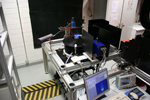Test facility turbulent flame

Aim
Turbulent gas flames are of high practical importance. This test facility is used for the investigation of reaction processes in turbulent premixed and non-premixed methane flames at atmospheric pressure. For that purpose qualitative and quantitative instantaneous species concentration distributions of combustion-related species and temperature are determined with laser-based methods. Additionally, the luminescence of electronically excited molecules (chemiluminescence) in the flame is observed. The measurements provide input for the modeling of turbulent reactive flows. They also allow to further develop the quantitative understanding of chemiluminescence that can be detected from turbulent flames. This is of interest for making the simple chemiluminescence detection a quantitative tool for flame studies and for control systems in industrial applications. The aim of this work is to further develop laser-based methods and to contribute to the development of chemiluminescence sensors.
Approach
In the facility a 30 kW swirl burner is used, which has a moveable-block design to adjust the swirl number and thus, turbulence. The burner has a circular nozzle with a bluff-body in the center to provide flame stabilization. It can be operated either with premixed, or non-premixed gases. The visualization of species distributions in the flame is carried out by detection of laser-induced fluorescence (LIF), using intensified CCD-cameras and 2D uv-laser-lightsheet techniques. Temperature information can be obtained from the detection of Rayleigh scattering. The distribution of heat-release is determined based on an approach that combines measured OH- and CH2O-LIF intensities. In order to investigate correlations between LIF and chemiluminescence signals, additionally spectrally resolved chemiluminescence is detected with optical sensors in combination with optical filters or spectrometers.
References
Böckle, S.; Kazenwadel J.; Kunzelmann, T.; Shin, D.-I.; Schulz, C.; Wolfrum, J. Proc. Combust. Inst. 28, 279-286 (2000) | Böckle, S.; Kazenwadel, J.; Kunzelmann, T.; Schulz, C. Appl. Phys. B 71, 741-746 (2000).
Contact
Dr. T. Endres, Torsten Endres , Tel +49 203 379 3505, IVG
